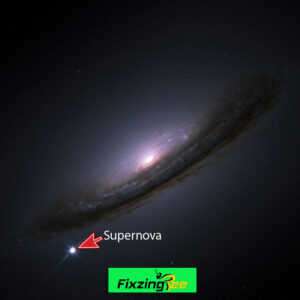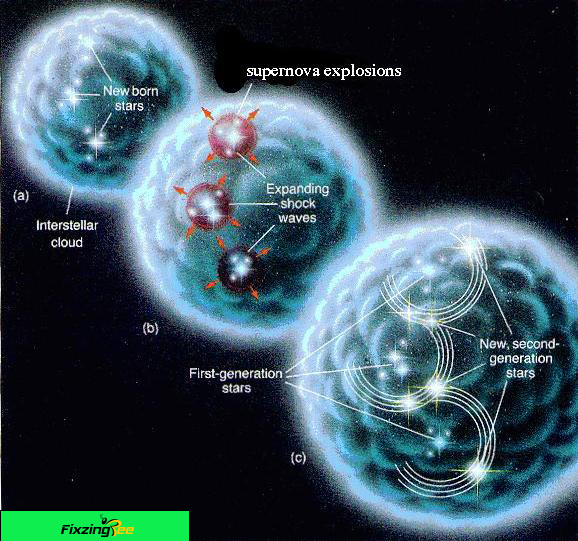Contents
What is Supernova?

It may sound ridiculous to someone but the stars do indeed die in our universe. There are millions or billions of stars in the universe which are dying every day. But the question is this supernova has been continuously happening after the Big Bang. So, if they have been dying then how still we could see stars in the sky? At first, I heard about the supernovas (stars dying) system. One day, a question comes to my mind that if the stars are dying in the universe, they should someday vanish from the universe. But this is not happening we can still see thousands of stars in the sky. Yes! Starts are also born. The death of a star is called a supernova. Basically, the supernova is an explosion of a large star.
Birth of a star:
When we look at the sky we see lots of stars in space. What is space exactly? According to the knowledge encyclopedia book space is “When you look into the blackness of the night sky, you are peering into the fathomless depths of the Universe, Stars, planets, and galaxies stretch into space, not just farther than you can see, but farther than you can imagine.”
Stars have been creating throughout the universe. Their shape is like a colossal cloud. Stars are born at a time from these colossal clouds of dust and the supernova explosions. The clouds of the newborn stars are cold and dense. The newborn stars mainly consist of hydrogen gas. When a newborn star is born it basically formed by some gasses like hydrogen, helium, and some amounts of other elements. The maximum materials are stored tightly in the core of the star. In this core, the nuclear reactions release energy in the form of heat and light.
The form of a new star:
When the cloud becomes unstable and breaks up into fragments then the star-forming process begins. Even the old star’s dust also helps to create a new star. Because of the gravitational pull, the material in a fragment into an ever-tighter clump, and as it shrinks the clump slowly forms a sphere. This is the early stage of a star and it’s called a protostar. The protostar keeps on shrinking. The core of this protostar getting denser and hotter. Nuclear reactions begin when the pressure and the temperature are so high and the stars start to shine.
A star passes three forms in its lifetime.

1- Interstaller cloud form of a star:
Interstellar cloud form is the first form of a star. In this form, the star remains very cold, with dense clouds of gas and dust. If something disturbs the cloud then the process of star formation may be triggered. For example collision with another cloud or a shockwave from a supernova explosion are responsible for this.
2- Fragments form of a star:
The second form is the fragments form. In this form, the cloud breaks into fragments of different sizes and masses. The most massive and dense of these fragments are gradually pulled by their own gravity into tighter clumps. These shrinking fragments will eventually turn into a protostar.
3- Protostar form:
The protostar form is the third and the very early stage of a star. A star gains its shape at this form. In this form, gravity pulls material into its core, where the density, pressure, and temperature build up. If the origin clouds fragment contains massive matter then the temperature and pressure rise as the protostar develops.
What is a nebula?

Clouds of gas and dust in space are called nebulas. The maximum of the gas and the dust in a nebula comes from old stars that exploded when they ran out of fuel. This material is recycled to create new stars over millions of years. In space, the Starbirth nebulas are the most beautiful object because of their colorful clouds that are illuminated from within by the blue light of newborn stars.
There is another nebula which is called the Orion Nebula. This is one of the closest star-forming regions to the earth. In the night sky, the Orion Nebula looks like a fuzzy star in the sword of Orion. Basically, it is a vast cloud of gas and dust that is thousands of times bigger than the solar system.
Death of a star (Supernova):
Every star looks bright just because of their explosions. Stars contain a vast number of gasses. But the fact is all stars eventually run out of fuel and die. Most fade away quietly, but the most massive stars self-destruct in a huge explosion that can outshine an entire galaxy.
A star’s death depends on how much matter it contains and also depends on how powerfully its core is squeezed by gravity. Stars make heat and by the process of nuclear fusion, they generate light. This is the light we see with the naked eye in the night sky. Our sun is also a star it’s called the White Dwarf Star.
When the hydrogen in the core runs out of small stars then the star’s light slowly fades. But in massive stars, the core is so hot and dense that the fusion can spread beyond it. The most massive stars are eventually overwhelmed by their own gravity, which crushes them so violently that they collapse into a pinprick to create a black hole.
Stars ways to die:
We already know that our sun is also a star and it will also follow the way of death. But not yet because the sun still has enough fuel to keep shining for approximately the next 5 billion years. So, you don’t need to worry about it. When larger stars die, they turn hydrogen into heavier chemical elements such as carbon and oxygen, which are later recycled to form new stars and planets. All the atoms in your body were created this way.
Stars can die in four different ways:
1- Stable Star:
Every newborn/young star goes through a stable phase in which it shines steadily. This is called the stable star.
2- Small Stars:
Stars with less than half the mass of the Sun fade away very slowly. The star begins to feed off hydrogen in its atmosphere when the hydrogen in the core is used up. It can’t generate enough gravity to use other elements as fuel. In that case, it slowly shrinks to become a black dwarf. This will take far longer than the age of the universe up to a trillion years.
3- Medium Stars:
When a Sunlike star has used up the hydrogen in its core, nuclear fusion spreads outside the core, making the star expand into a red giant. The core collapses until it is hot and dense enough to fuse helium, but eventually, it runs out of helium too. Finally, it becomes a white dwarf, and its outer layers spread into space like a cloud of debris.
4- Massive Stars:
The massive stars are over eight times more massive than our sun. The heat and pressure inside the core become so great that nuclear fusion can not only fuse hydrogen atoms to form helium but can fuse helium and larger atoms to create elements such as carbon or oxygen. As this takes place, the star swells into the largest star of all: a supergiant.